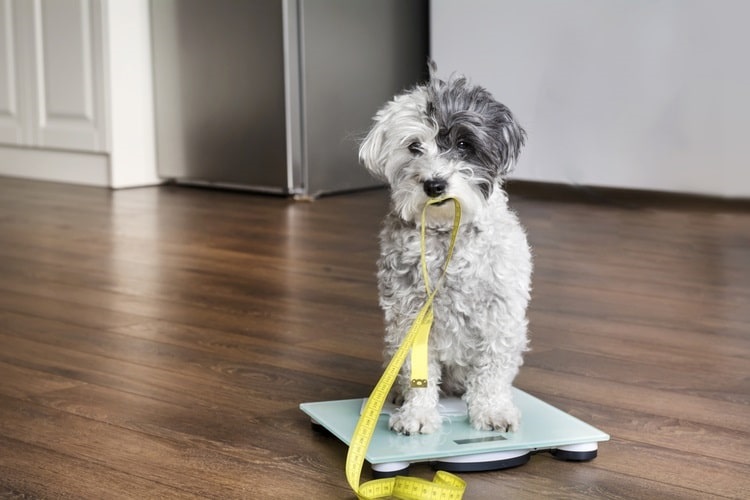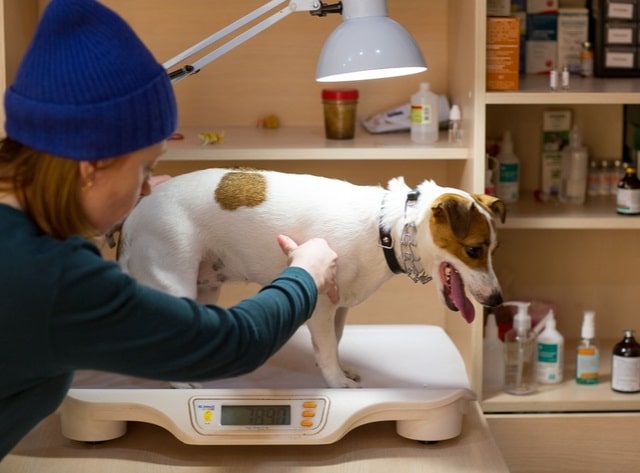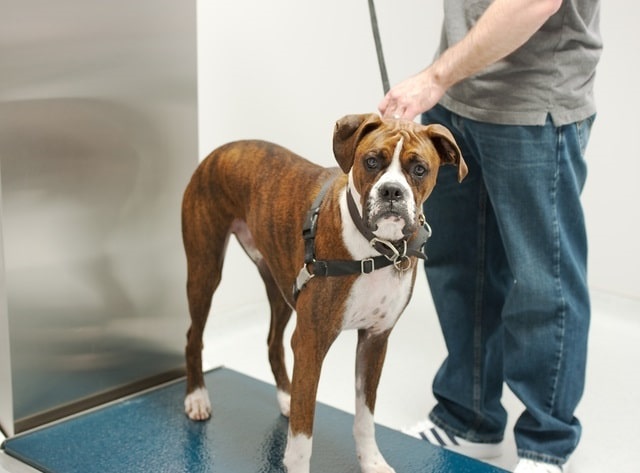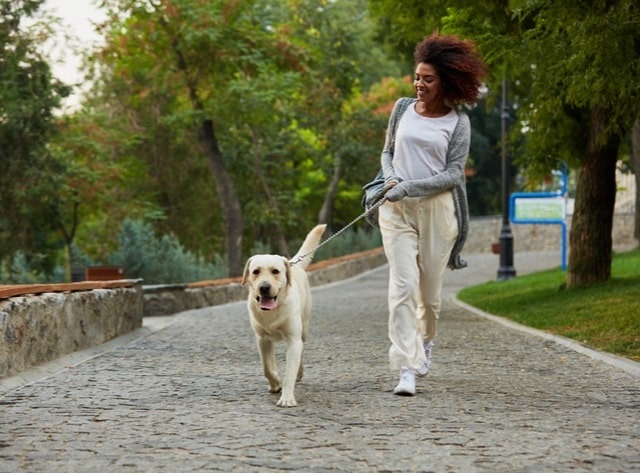Most dog owners will ask at some point in their dog’s life: how heavy should my dog be?
Does your dog look like an ottoman, or do you see an hourglass figure when you look down? If you said ottoman, then your pet is overweight, even obese. You could be doing them a disservice by not addressing it now. So, how heavy should your dog be? Or better yet, what is your dog’s ideal body weight?
What is My Dog’s Ideal Body Condition?
Remember that no two dogs are exactly alike. Your dog’s body condition needs to be evaluated individually! To put it plainly, you should be able to feel your dog’s ribs easily, and your pet should have a waist at the end of the ribcage.
Veterinarians determine a pet’s ideal weight based on a variety of factors. Let’s take a closer look at the factors that determine your pet’s ideal weight.
Visual Evaluation
From a distance, a vet gets a general idea of your dog’s overall appearance.
Palpation
Palpation means your vet will put their hands on the pet. By evaluating the quality of the muscle and overall body condition, the dog’s body weight, and overall physical appearance, your veterinarian gets a clear picture of your dog’s overall body health.
Body Condition Score (BCS)
The body condition score evaluates your pet’s overall stature. It evaluates the ease of feeling the ribs and the overall amount of body fat. It is measured on a scale from 1 to 9, with 1-3 being underweight (too thin), 4-5 being ideal, and 6-9 being overweight to obese (too heavy).1
See the following examples of BCS charts used by veterinarians today. They provide pictures to demonstrate the differences at each level:
- WSAVA Body Condition Score
- Nestle Purina Body Condition System (published on the Morris Animal Foundation website)
Muscle Condition Scoring (MCS)
With the MCS, we are evaluating muscles along the spine, shoulders, head, and hips. We assess for muscle loss. As animals age, they naturally lose muscle mass, but it also occurs with underlying diseases, including obesity. This loss of muscle in obese pets may make your pet appear less obese, but they are still unhealthy.2
The BCS and the MCS are not directly related.
Overall, we can get a general impression of BCS and MCS with just a visual exam. Still, palpation is needed to determine if there is normal muscle tone and the degree of fat present.3
Feel free to look at this website for an additional explanation and pictures.
Actual Body Weight
The number on the scale helps us establish a baseline, giving us something to compare from one evaluation to another. The number may suggest a pet is overweight, underweight, or just right when compared to breed standards. However, the number itself tells us very little. It lacks context. If I said that a human female weighed 90 pounds, many questions need to follow. What is the person’s age, height, activity level, muscle condition, and more?
We can use breed reference ranges for pure breed dogs as a starting point, but this cannot be the only factor evaluated. When used, these standards will often overestimate or underestimate a dog’s ideal weight. Even if your dog’s weight falls within the standard range, your pet could still be overweight or obese.
Pure Breed Dogs
Breed standards provide a weight range for the average representative female and male of that breed. Just because we have these ranges doesn’t mean that a pet has to fall within them to be healthy.
These breed standards help generate data for some of the bodyweight calculators out there.
Feel free to check out this puppy calculator. It provides a helpful guide and an idea of what a puppy should weigh.
Remember that new puppies grow, and the amount they need over time increases. These calculators help provide a launching point but combined with the other factors mentioned here, they further help refine a dog’s optimal body weight.
Mixed Breed Dogs
Mixed breeds, or purebred mutts, are simply a combination of two or more breeds. It is much harder to establish a standard weight range acceptable for these dogs. This further emphasizes the need to evaluate several factors when determining your dog’s ideal body weight.
Obesity in Dogs
Why do you need to know what your dog’s ideal body weight should be?
Because if our pet becomes under or overweight, this can lead to unnecessary and preventable health conditions.
In the United States before COVID-19, obese dogs accounted for 10-40% of the total dog population. After COVID-19 quarantines with owners living and working at home, this percentage has increased. A recent 2021 study suggests that obese dogs in various countries worldwide have risen to over 50%.4 5
We cannot control our dogs’ genetics, breed, age, or sex. But we do control if they are neutered/spayed, what food they eat and how much. Pet owners also moderate energy expenditures, and increasing exercise can help prevent obesity.
Obesity leads to decreased quality of life, a decreased lifespan, arthritis, and other diseases. But pets do not become obese by choice.67
What is obesity?
Obesity is a medical condition whereby a pet weighs greater than 10-20% more than its ideal weight.81011
Obesity can lead to many problems and needs to be taken seriously.1213 These problems may include:
- Diabetes
- Exercise and heat intolerances
- Heart disease
- Increased anesthetic risk
- Musculoskeletal disorders (Joint, bone, muscle)
- Skin problems
- Weakened immune system making them more at risk of other diseases
- Shortened lifespans
Many people fail to understand the complexities and problems that can occur secondary to obesity. They see it as cute or funny that their pet looks like a tick. Recommendations for weight loss are often ignored. Their very suggestion is taken as an insult rather than exactly what it is, a veterinarian wanting what is best for their patient.
What steps can you take to prevent obesity?
Follow these important steps to help prevent canine obesity:
- Ensure plenty of aerobic exercise – especially leash walks.
- Ensure treats make up only 10% of the total calories per day.
- Adjust feeding amounts based on level of activity, age, sex, if spayed/neutered or not.
- Regularly assess your pet’s weight.
- Use a measuring cup when feeding.
- Note that often the amounts suggested on food bags and cans exceed the average dog’s needs. Talk with your veterinarian to discuss feeding recommendations.
Are treats the culprit?
Most people simply overfeed their dogs.14 This may occur because:
- Owners fail to use a measuring cup for dry kibble.
- Owners fail to consider the table food, treats, and other snacks and the caloric content they contain.
- In addition to dry food, wet food may be provided, and the dry food isn’t adjusted for the added calories.
- Bored dogs ask for food, so they receive it.
- Owners fail to recognize obesity.
Quite often, the main culprit for obesity starts off at least because of treat administration. Table food, often not considered in the same category as a treat, is just that, a treat. Studies have shown that dogs given table food are more likely to be obese.15
We often use food to show affection and reward behavior when a chin scratch, butt rub, or toy playing session can be just as rewarding to the pet, if not more so. For some reason, humans associate giving food with love. But too much food can cause harm!
A good rule of thumb
Make sure daily treats provide no more than 10% of your pet’s total daily calories. ‘Treats’ include commercial treats, table scraps, dental chews, and others.16 Anything more than that diminishes nutrition and can increase weight.
Check out these resources below (as well as our own list of human foods dogs can and cannot eat). They help demonstrate pet treats in human terms. It’s a real eye-opener when you see how many cheeseburger-equivalents your pet actually eats daily.
- What Human Food Does to Your Pet: Human Caloric Equivalents
- Are you giving your dog too many high-calorie treats?
Remember, the smaller the breed, the fewer calories they need daily. Even though a piece of chicken seems healthy, when given along with the dog food and a few dog treats during the day, one can easily exceed the pet’s daily needs leading to obesity over time.
How to Ensure a Healthy Weight for Your Dog
Once you’ve established how heavy your dog should be, you need to ensure that the pet remains at a healthy weight throughout life. Changes will need to be made in feeding amounts based on a variety of factors such as the amount of daily exercise, the time of year, the weather, and as the pet ages.
Make sure to prevent obesity and provide your pet with regular controlled exercise. Daily walking, for example, has benefits beyond just weight management potential.
- Leash walking helps to strengthen the human-animal bond.
- It provides enrichment by allowing sniffing and investigation of the environment.
- It provides visual and olfactory stimulation (things to see and things to smell).
Regularly Have Your Pet’s Weight Evaluated by Your Veterinarian
If you evaluated your dog and didn’t find an hourglass figure, but your pet isn’t yet an ottoman, good. We can intervene before obesity sets in. Now is the time to discuss weight management with your veterinarian.
Veterinarians recommend several options to help pets lose weight:
- Establish an exercise program
- Caloric restriction under veterinary supervision
- Eliminating high calorie treats from the diet, including people food, table scraps, and commercial treats
- Prescription weight-loss diets
- Note: It is often unsafe to calorie restrict effectively with over-the-counter foods.
- Prescription foods offer a variety of ways to help your pet lose weight.
- Re-evaluate how we show affection
- For example, we can eliminate many excess calories by changing from treats to a favorite toy reward for good behavior or performance.
- Remember, dogs do not need table food, human food, or treats. When fed a well-balanced diet, what they need are human-animal interaction and environmental enrichment.17
A Few Words of Caution
Breed standards are just that: standards. We do not expect all dogs to meet every specification for a specific breed. Additionally, mixed breed dogs abound. We do not have standards for them, and we shouldn’t try to mold them into one breed or another. Like reference ranges for tests and height and weight charts for kids, breed standards represent the average. They do not account for variability and other factors.
To determine if your pet has achieved an ideal weight, include additional information such as BCS, MCS, and your hands-on evaluation in your decision.
Remember a Few Things about Your Dog’s Ideal Weight
Several factors go into assessing your pet’s overall body condition. A visual assessment, actual weight, MCS, BCS, and palpation all help to determine if your pet should shed a few of those surplus pounds.
Sometimes, we can love our pets too much by showing affection and love with food. Remember that you do not need to give treats to show love or to reward during training. Instead of a treat, substitute a favorite ball or toy, a game of fetch, or some chin scratches (or that favorite place your pet loves to be petted), to reward your dog. And remember that you can overfeed your pet.
If you want to know more about the ideal weight for different breeds we initially created five growth charts: a Goldendoodle size chart, a Golden Retriever growth chart, Great Dane size chart, Chihuaha growth chart, or Labrador size chart. By popular demand we’ve recently added an additional series of growth charts:
- Dog Growth Chart
- Mixed Breed Growth Chart
- Rottweiler Growth Chart
- Pit Bull Growth Chart
- Australian Shepherd Growth Chart
- French Bulldog Growth Chart
- Great Pyrenees Growth Chart
- Standard Poodle Growth Chart
- Bernedoodle Growth Chart
- Husky Growth Chart
Dogs do not become obese alone. Humans provide them with food, so we safeguard that they do not become too heavy.
Keeping your dog at an ideal weight not only improves the pet’s quality of life overall but helps to minimize the risk of diseases such as arthritis, heart disease, diabetes mellitus, and more. When your pet feels good, moves around well, and engages in the environment, this helps to strengthen your bond. Contrary to popular belief, the human-animal bond doesn’t need to be fed by food and treats. It can be nourished by affection, love, environmental enrichment, and physical and mental activity.
Article Sources
Pet News Daily uses only high-quality sources, including peer-reviewed studies, to support the facts within our articles. Read our editorial process to learn more about how we fact-check and keep our content accurate, reliable, and trustworthy.
- Buzhardt L. Body Condition Scores. Vcahospitals.com. Published 2021. Accessed August 18, 2021.
- American Animal Hospital Association (AAHA). BCS and MCS. Aaha.org. Accessed August 18, 2021.
- American Animal Hospital Association (AAHA). BCS and MCS. Aaha.org. Accessed August 18, 2021.
- American Animal Hospital Association (AAHA). BCS and MCS. Aaha.org. Accessed August 18, 2021.
- Kluess HA, Jones RL, Lee-Fowler T. Perceptions of Body Condition, Diet and Exercise by Sports Dog Owners and Pet Dog Owners. Animals. 2021;11(6):1752. doi:10.3390/ani11061752
- Bland I. Tackling dog obesity by tackling owner attitudes. CAB Rev Perspect Agric Vet Sci Nutr Nat Resour. 2011;6(006). doi:10.1079/PAVSNNR20116006
- German AJ, Holden SL, Wiseman-Orr ML, et al. Quality of life is reduced in obese dogs but improves after successful weight loss. Vet J. 2012;192(3):428-434. doi:10.1016/j.tvjl.2011.09.015
- Bland I. Tackling dog obesity by tackling owner attitudes. CAB Rev Perspect Agric Vet Sci Nutr Nat Resour. 2011;6(006). doi:10.1079/PAVSNNR20116006
- 9Bland IM, Hill J. Dog obesity: Keeping the weight off. Vet J. 2012;192(1):3. doi:10.1016/j.tvjl.2011.08.002
- Robertson ID. The association of exercise, diet and other factors with owner-perceived obesity in privately owned dogs from metropolitan Perth, WA. Prev Vet Med. 2003;58(1):75-83. doi:10.1016/S0167-5877(03)00009-6
- Robertson ID. The association of exercise, diet and other factors with owner-perceived obesity in privately owned dogs from metropolitan Perth, WA. Prev Vet Med. 2003;58(1):75-83. doi:10.1016/S0167-5877(03)00009-6
- Courcier EA, Mellor DJ, Thomson RM, Yam PS. A cross sectional study of the prevalence and risk factors for owner misperception of canine body shape in first opinion practice in Glasgow. Prev Vet Med. 2011;102(1):66-74. doi:10.1016/j.prevetmed.2011.06.010
- Webb TL, du Plessis H, Christian H, Raffan E, Rohlf V, White GA. Understanding obesity among companion dogs: New measures of owner’s beliefs and behaviour and associations with body condition scores. Prev Vet Med. 2020;180:105029. doi:10.1016/j.prevetmed.2020.105029
- Heuberger R, Wakshlag J. The relationship of feeding patterns and obesity in dogs. J Anim Physiol Anim Nutr. 2011;95(1):98-105. doi:10.1111/j.1439-0396.2010.01024.x
- White GA, Ward L, Pink C, Craigon J, Millar KM. “Who’s been a good dog?” – Owner perceptions and motivations for treat giving. Prev Vet Med. 2016;132:14-19. doi:10.1016/j.prevetmed.2016.08.002
- Clark M. 5 Ways To Show Your Dog Love That They Can Understand. Dogtime.com. Published 2020. Accessed August 18, 2021.




